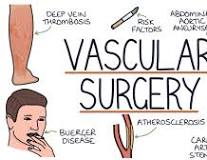The Importance of Vascular Surgeries in Maintaining Cardiovascular Health
Vascular surgeries play a crucial role in the management and treatment of various cardiovascular conditions. The vascular system, comprising arteries, veins, and lymphatic vessels, is responsible for transporting blood and nutrients throughout the body. When this system is compromised due to diseases or disorders, it can lead to serious health complications.
One common condition that often requires vascular surgery is peripheral artery disease (PAD). PAD occurs when plaque buildup narrows the arteries in the legs, reducing blood flow to the lower extremities. Vascular surgeries such as angioplasty and bypass procedures can help restore proper blood circulation and alleviate symptoms such as leg pain and cramping.
Another critical area where vascular surgeries are essential is in the treatment of aneurysms. An aneurysm is a bulge or weakening of a blood vessel wall that can potentially rupture and cause life-threatening bleeding. Surgical interventions like endovascular aneurysm repair (EVAR) or open aneurysm repair are performed to prevent rupture and restore vascular integrity.
Vascular surgeries also play a vital role in managing conditions like deep vein thrombosis (DVT), varicose veins, and carotid artery disease. By improving blood flow and reducing obstructions within the vascular system, these procedures help prevent complications such as stroke, pulmonary embolism, and chronic venous insufficiency.
Advancements in surgical techniques and technologies have significantly improved the outcomes of vascular surgeries, making them safer and more effective than ever before. Minimally invasive procedures like endovascular stenting have reduced recovery times and post-operative complications for many patients.
In conclusion, vascular surgeries are indispensable tools in the treatment of various cardiovascular conditions. By addressing issues within the vascular system promptly and effectively, these procedures help maintain optimal blood flow, reduce risks of complications, and improve overall cardiovascular health.
Understanding Vascular Surgeries: Common Procedures and Conditions
- Which are vascular surgery?
- What is the most common vascular surgery?
- What are the two common vascular surgery procedures?
- What is the most common vascular disease?
Which are vascular surgery?
Vascular surgeries encompass a range of procedures that target the blood vessels, arteries, and veins to address conditions affecting the circulatory system. These surgeries are designed to treat a variety of vascular disorders, including peripheral artery disease, aneurysms, varicose veins, and deep vein thrombosis. Vascular surgeons utilise advanced techniques such as angioplasty, stenting, bypass grafting, and endovascular repair to restore proper blood flow and prevent serious complications. By focusing on the health and integrity of the vascular system, these surgeries play a crucial role in maintaining cardiovascular wellness and overall quality of life for patients.
What is the most common vascular surgery?
The most common vascular surgery is likely endovascular procedures such as angioplasty and stenting. These minimally invasive techniques are often used to treat conditions like peripheral artery disease (PAD) and blockages in the arteries. Angioplasty involves inflating a small balloon to widen a narrowed artery, while stenting involves placing a mesh tube to keep the artery open. These procedures have become popular due to their effectiveness in restoring blood flow and improving symptoms, with many patients experiencing quicker recovery times compared to traditional open surgeries.
What are the two common vascular surgery procedures?
Two common vascular surgery procedures are angioplasty and bypass surgery. Angioplasty involves widening narrowed or blocked arteries using a balloon-like device to improve blood flow. This minimally invasive procedure is often used to treat conditions such as peripheral artery disease. Bypass surgery, on the other hand, involves creating a detour around a blocked artery using a graft to restore proper blood circulation. This surgical intervention is commonly performed to treat severe arterial blockages in the heart or legs. Both procedures aim to improve vascular health and alleviate symptoms associated with restricted blood flow.
What is the most common vascular disease?
The most common vascular disease is atherosclerosis, a condition characterised by the build-up of plaque within the arteries. Atherosclerosis occurs when cholesterol, fat, and other substances accumulate on the inner walls of blood vessels, leading to narrowing and hardening of the arteries. This process restricts blood flow and can increase the risk of serious complications such as heart attacks, strokes, and peripheral artery disease. Managing atherosclerosis through lifestyle changes, medication, and in some cases, vascular surgeries like angioplasty or bypass procedures is crucial in preventing its progression and reducing associated health risks.

